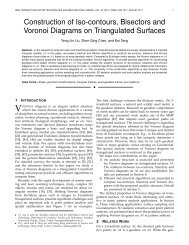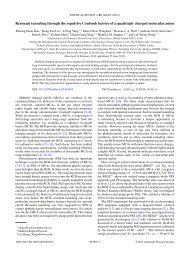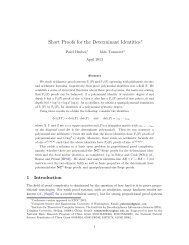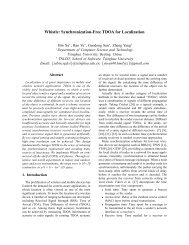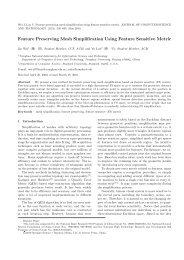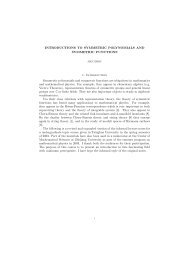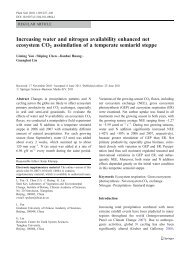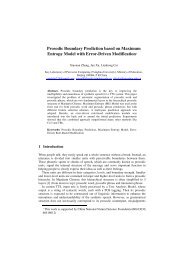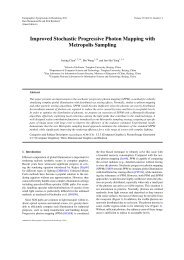Industrial design using interpolatory discrete developable surfaces
Industrial design using interpolatory discrete developable surfaces
Industrial design using interpolatory discrete developable surfaces
You also want an ePaper? Increase the reach of your titles
YUMPU automatically turns print PDFs into web optimized ePapers that Google loves.
Y.-J. Liu et al. / Computer-Aided Design 43 (2011) 1089–1098 1093and then convert P into a simple polygon P ′ , for which the rules(2–6) can be applied.To guarantee OT(P) = OT(P ′ ), the choice of cutting rungs isimportant. Let v i c be a vertex on the convex hull of a hole H i. v i c iscalled a sink if every rung in L(v c ) connects H i to Q . We have thefollowing two properties:Fig. 7. A composite <strong>developable</strong> surface: Three cone patches joined with a plane,and the boundary curve is shown in red. (For interpretation of the references tocolour in this figure legend, the reader is referred to the web version of this article.)Recall that if e ∈ P, m(e) = 0, i.e., M(T) does not count theedges in P, we can slightly modify the above rule to include theOBT case:M(OT(P(⟨i, j⟩ + ))) = max{M(OT(P(⟨i, x⟩ + ))) + m(⟨i, x⟩)+ M(OT(P(⟨x, j⟩ + )))+ m(⟨x, j⟩) : x ∈ (V(i) ∪ i + 1)∩(V(j) ∪ j − 1) ∩ P(⟨i, j⟩ + )}. (6)By <strong>using</strong> rules (2) and (6) with the boundary conditions specifiedby rules (2–5), the general OT is found after the recursion of thetop–down dynamic-programming algorithm. Note that the rungvisibilityis locally updated after each marching step, so that V(i)and V(j) only contain non-visited vertices.To implement the algorithm, we need to compute the rungvisibilityset V(i) for all vertices in P. This equals building a visibilitygraph VG(P) of a simple polygon P and removing the edges in Pfrom VG(P). We use the optimal output-sensitive algorithm in [34]to build VG(P) in O(m + n log log n) time, where m is the numberof edges in VG(P).4.3. Optimal triangulation of multiple closed curvesGenerally a <strong>developable</strong> surface can have multiple closed curvesas its boundary. Our sketching interface provides an flexibletool for constructing this kind of boundary with continuousinteractive editing: First, multiple planar closed curves that enclosea multiple-connected region are specified in the sketch plane; thenthe handle points of B-spline curves are modified along the normaldirection to make 3D boundaries.Consider a non-simple polygon P in the sketch plane which isbounded by the curve set Ω = {Q , H 1 , H 2 , . . . , H m }, where Q isthe external closed boundary curve and H 1 , H 2 , . . . , H m are m nonintersectingholes forming the internal boundary of P. The verticeson holes are ordered counter-clockwise, so that when one walksalong the boundary Ω, the interior region is always on the righthandside. Refer to Fig. 8. Our strategy is to cut P along some rungsProperty 4.1. If three sequential vertices v i j−1 , vi j , vi j+1 of H i lie on theconvex hull of H i , then any boundary triangulation of P must containat least one rung in L(v i j ) that connects H i to another boundary curvein Ω \ H i .Proof. Denote the three sequential vertices of H i that lie on theconvex hull of H i , in counter-clockwise order, by v i j−1 , vi j and vi j+1 .If Property 4.1 does not hold, then all the rungs in L(v i) j connect vi jto some other vertex v i k of H i. Since (1) any boundary triangulationT of P contains v i jas a vertex which has a degree no smaller than3, and (2) two edges (v i , j−1 vi) j and vi, j vi j+1lie on the convex hull ofH i , all remaining edges (a nonempty set) in T which are incident tov i j must cross the interior of hole H i. That is a contradiction to thedefinition of boundary triangulation. So Property 4.1 holds. □Property 4.2. If three sequential vertices v i j−1 , vi j , vi j+1 of H i lie on theconvex hull of {H 1 , H 2 , . . . , H m }, then v i jis a sink and any boundarytriangulation of P must contain at least one rung in L(v i j) that connectsH i to Q .Proof. Let Ω be the convex hull of inner boundaries (H 1 , H 2 , . . . ,H m ), and v i j−1 , vi j , vi j+1 be three sequential vertices of H i, in counterclockwiseorder, lying on Ω. If v i jis not a sink, then all the rungs inL(v i) j connect vi jto some other vertex v j k of H j. Since v i , j−1 vi j , vi j+1lies on Ω, all the rungs in L(v i) j must cross the interior of hole H i, acontradiction. So Property 4.2 holds. □Since boundary Ω consists of smooth curves, if the sampling ofΩ is sufficiently dense, a sink vertex always exists. Based on theProperties 4.1 and 4.2, we use the following procedure to find anoptimal set of cutting rungs.Step 1. Let external boundary be Q and internal boundary H ={H 1 , H 2 , . . . , H m }.Step 2. Find the convex hull of H and identify a sink vertex v c .Step 3. For every rung l in L(v c ).Step 3.1. Cut the region <strong>using</strong> l which connects a H k to Q ;Step 3.2. Set Q = Q ∪ H k and H = H \ H k ;Step 3.3. If H ≠ ∅.Step 3.3.1. Go to Step 2.Step 3.4. Else stop.The convex hull of a simple polygon can be efficiently foundin linear time [35]. To find the convex hull of several polygons,we apply the marriage-before-conquest method in [36] that runsin O(n log h) time, where n is the number of vertices of inputpolygons and h is the number of vertices on the output hull. Finally,for helping identify sink vertices, we use the output-sensitivescheme in [37] to build the visibility graph of simple polygon Q,Fig. 8. Cutting a non-simple polygon into a simple one along some rungs.




